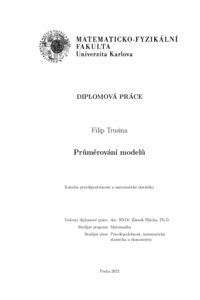Průměrování modelů
Model averaging
diplomová práce (OBHÁJENO)

Zobrazit/
Trvalý odkaz
http://hdl.handle.net/20.500.11956/173569Identifikátory
SIS: 228248
Kolekce
- Kvalifikační práce [10691]
Autor
Vedoucí práce
Oponent práce
Antoch, Jaromír
Fakulta / součást
Matematicko-fyzikální fakulta
Obor
Pravděpodobnost, matematická statistika a ekonometrie
Katedra / ústav / klinika
Katedra pravděpodobnosti a matematické statistiky
Datum obhajoby
8. 6. 2022
Nakladatel
Univerzita Karlova, Matematicko-fyzikální fakultaJazyk
Čeština
Známka
Dobře
Klíčová slova (česky)
průměrování modelů|MCP-Mod|závislost odpovědi na dávce|konfidenční intervalyKlíčová slova (anglicky)
model-averaging|MCP-Mod|dose-response|confidence intervalsCílem této práce je popsat metodu průměrování modelů a konstrukci konfidenčních in- tervalů pro odhad dávky v rámci metody MCP-Mod pro modelování závislosti odpovědi na dávce. V práci definujeme dávky EDp a MED, které se v praxi odhadují. Metodu MCP-Mod představujeme včetně vhodných modelů a kontrastních testů. Představujeme informační kritéria, možnost určení vah modelů na základě informačních kritérií a disku- tujeme jejich chování pro různé modely a rostoucí počet pozorování. Dále před- stavujeme tři možné způsoby konstrukce konfidenčních intervalů pro odhady získané pomocí metody průměrování modelů. Aplikujeme tyto konstrukce na příkladu mod- elování závislosti odpovědi na dávce v simulační studii. Na závěr práce představíme dva nové modely s dvěma body změny pro modelování závislosti odpovědi na dávce. 1
The thesis aims to describe the method of model averaging and the construction of confidence intervals for dose estimation within the method MCP-Mod that is used for modeling the dose-response relationship. We define the doses EDp and MED, which are estimated in practice. We describe the MCP-Mod method, including suitable mod- els and contrast tests. We present information criteria, the ability to determine model weights based on information criteria and discuss their behaviour for different models and a growing number of observations. We also introduce three possible ways of con- structing confidence intervals for estimates obtained using the model averaging method. We apply these constructs to the example of dose-response modeling in a simulation study. Lastly, we introduce two new models with two change-points for modeling the dose-response relationship. 1
